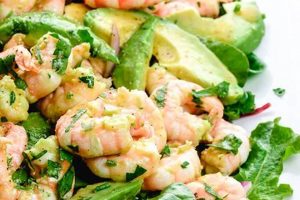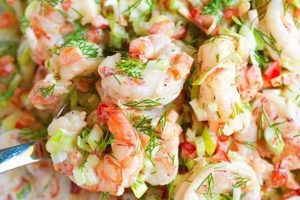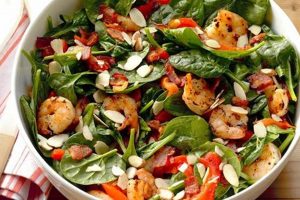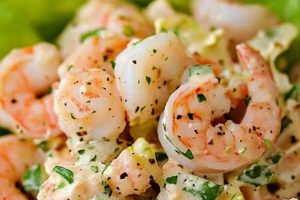A dish featuring crisp romaine lettuce, tossed in a creamy dressing traditionally made with egg yolks, olive oil, lemon juice, Worcestershire sauce, garlic, and anchovies, is often enhanced with croutons and Parmesan cheese. Adding cooked shrimp creates a flavorful, protein-rich variation. Numerous versions exist, incorporating ingredients like bacon, avocado, or different types of lettuce.
This combination offers a balance of textures and flavors, from the succulent seafood and crunchy lettuce to the rich, savory dressing. It’s a relatively simple dish to prepare, making it suitable for casual meals or more formal occasions. The historical evolution from Caesar Cardini’s original creation to the numerous adaptations seen today demonstrates the enduring appeal of this adaptable salad.
The following sections will delve into specific ingredient choices, detailed preparation instructions, nutritional information, and variations to customize this classic dish.
Tips for a Superior Caesar Salad with Shrimp
Elevating this classic dish requires attention to detail and an understanding of the interplay of flavors and textures. The following tips offer guidance for creating a truly exceptional culinary experience.
Tip 1: Shrimp Selection and Preparation: Opt for high-quality, fresh or properly frozen shrimp. Thawing should be done slowly in the refrigerator to maintain optimal texture. Overcooking results in rubbery shrimp; cook just until pink and opaque.
Tip 2: Romaine Lettuce Handling: Use crisp, cold romaine hearts. Thoroughly wash and dry the leaves to prevent a watery salad. Tear the leaves into bite-sized pieces rather than chopping, which can bruise the lettuce.
Tip 3: Dressing Emulsification: A stable emulsion is key to a creamy, flavorful dressing. Whisking ingredients vigorously or using a blender creates a smooth, cohesive texture. Adding the oil gradually while whisking ensures proper emulsification.
Tip 4: Crouton Creation: Homemade croutons offer superior flavor and texture. Use day-old bread, cut into cubes, and toss with olive oil, herbs, and spices before baking or pan-frying until golden brown and crisp.
Tip 5: Parmesan Cheese Quality: Freshly grated Parmesan cheese provides the best flavor and melts beautifully onto the salad. Avoid pre-grated cheese, which often contains cellulose and lacks the nuanced flavor of freshly grated.
Tip 6: Balancing Flavors: The Caesar dressing is rich and savory; balance the intensity by ensuring the lettuce is properly dried and the shrimp is seasoned appropriately. A squeeze of fresh lemon juice can brighten the overall flavor profile.
Tip 7: Ingredient Timing: Add the croutons and cheese just before serving to maintain their texture. The shrimp can be added slightly earlier, allowing it to absorb some of the dressing’s flavor.
By following these guidelines, one can create a Caesar salad with shrimp that showcases balanced flavors, pleasing textures, and a sophisticated presentation.
The following section offers a comprehensive recipe, incorporating these tips for a truly remarkable dish.
1. Fresh Ingredients
The quality of a shrimp Caesar salad is fundamentally linked to the freshness of its ingredients. Using fresh components elevates the flavor profile, enhances the textural nuances, and contributes to a more satisfying dining experience. Subpar or stale ingredients can detract significantly from the final product.
- Shrimp:
Fresh, high-quality shrimp is essential. It should have a firm texture, a clean, slightly sweet aroma, and a translucent appearance. Avoid shrimp with a strong fishy odor or mushy texture. Fresh shrimp contributes a delicate, sweet flavor to the salad, contrasting beautifully with the savory dressing. Using frozen shrimp is acceptable if thawed correctly, but fresh shrimp provides the optimal flavor and texture.
- Romaine Lettuce:
Crisp, vibrant romaine lettuce forms the foundation of the salad. It should be cold and firm, with no signs of wilting or browning. Fresh romaine provides a satisfying crunch and a slightly bitter flavor that balances the richness of the dressing. Washing and drying the lettuce thoroughly is crucial for preventing a watery salad.
- Parmesan Cheese:
Freshly grated Parmesan cheese offers a superior flavor compared to pre-grated varieties. It melts more readily and provides a sharper, more complex flavor profile. The salty, umami notes of fresh Parmesan enhance the overall savory character of the salad.
- Dressing Ingredients:
Using fresh ingredients for the Caesar dressing is equally important. Freshly squeezed lemon juice, high-quality olive oil, and fresh garlic contribute significantly to the dressing’s vibrant flavor. Fresh eggs, if used, must be of the highest quality for food safety reasons. These fresh components combine to create a dressing that is both rich and refreshing.
Prioritizing fresh ingredients in a shrimp Caesar salad ensures a superior culinary experience. The vibrant flavors and crisp textures combine harmoniously, resulting in a dish that is both satisfying and refreshing. Ignoring ingredient quality compromises the balance of flavors, negatively impacting the overall enjoyment of the dish.
2. Proper Shrimp Preparation
Proper shrimp preparation is crucial for a successful shrimp Caesar salad. The shrimp’s texture and flavor contribute significantly to the overall dish, and improper handling can result in rubbery, bland, or even off-tasting seafood, negatively impacting the salad’s quality. Several factors influence optimal shrimp preparation.
Thawing is the first critical step for frozen shrimp. Slow thawing in the refrigerator is recommended to maintain the shrimp’s delicate texture. Rapid thawing methods, such as microwaving or placing under hot water, can make the shrimp tough. Once thawed, the shrimp should be patted dry to ensure proper browning during cooking. Overcooking leads to a rubbery texture; cooking just until pink and opaque preserves the shrimp’s tenderness and flavor. Whether grilling, sauting, or boiling, careful attention to cooking time is paramount. Seasoning enhances the shrimp’s natural sweetness and complements the savory Caesar dressing. Simple seasonings like salt, pepper, and garlic powder are often sufficient, but more complex spice blends can add depth of flavor.
For example, overcooked shrimp in a Caesar salad detracts from the overall dining experience, creating an unpleasant, chewy texture that clashes with the crisp lettuce and creamy dressing. Conversely, properly prepared shrimp, succulent and flavorful, enhances the salad, adding a delightful textural and flavor dimension. Understanding and applying proper shrimp preparation techniques elevates the dish from merely acceptable to truly exceptional. This attention to detail demonstrates culinary expertise and ensures a more satisfying and enjoyable meal. The interplay of textures and flavors is optimized when the shrimp is handled with care and precision.
3. Classic Caesar Dressing
Classic Caesar dressing is integral to a successful shrimp Caesar salad recipe, providing the characteristic rich, savory flavor that defines the dish. The dressing’s creamy texture and umami notes complement the fresh shrimp and crisp romaine, creating a harmonious balance of flavors and textures. Understanding the components of a classic Caesar dressing and their interplay is essential for achieving an authentic and satisfying culinary experience.
- Emulsification:
A stable emulsion is fundamental to a classic Caesar dressing. The process of combining oil, egg yolks (or alternatives), and acidic elements like lemon juice or vinegar creates a creamy, cohesive texture. A properly emulsified dressing clings to the lettuce and other ingredients, ensuring even distribution of flavor. A broken emulsion results in a watery, unappetizing dressing that detracts from the salad’s overall quality.
- Umami:
The umami component is a hallmark of Caesar dressing. Traditionally derived from anchovies, Worcestershire sauce, or Parmesan cheese, umami provides a savory depth of flavor that balances the other ingredients. The subtle saltiness and rich, complex notes of umami enhance the shrimp’s sweetness and the romaine’s subtle bitterness.
- Garlic and Lemon:
Garlic and lemon juice contribute brightness and complexity to the dressing. The pungent garlic flavor complements the richness of the other ingredients, while the lemon juice adds a refreshing acidity that cuts through the richness. The balance between these two elements is crucial for avoiding a dressing that is overly pungent or tart.
- Variations:
While the classic Caesar dressing adheres to a traditional formula, variations exist. Some recipes incorporate Dijon mustard for added tang, while others use mayonnaise for a creamier texture. These variations can influence the overall flavor profile of the salad, offering opportunities for customization while maintaining the essence of a Caesar dressing.
The classic Caesar dressing’s interplay of emulsification, umami, garlic, lemon, and other ingredients is what elevates the shrimp Caesar salad from a simple combination of ingredients to a culinary classic. The dressing’s rich, savory character enhances the other components, creating a balanced and satisfying dish. Understanding and appreciating the nuances of a classic Caesar dressing contributes to a more informed and enjoyable dining experience. Variations can adapt to personal preferences, but a firm grasp of the fundamental principles ensures a consistently delicious outcome.
4. Homemade Croutons
Homemade croutons represent a significant opportunity to enhance the textural and flavor complexity of a shrimp Caesar salad. While store-bought croutons offer convenience, they often lack the nuanced flavor and satisfying crunch that freshly prepared croutons provide. The control over ingredients and preparation methods allows for customization and elevates the overall dining experience.
- Bread Selection:
The choice of bread significantly impacts the final crouton. Day-old, slightly stale bread, such as a baguette, sourdough, or Italian loaf, works best, as it absorbs the seasonings and crisps up beautifully. The bread’s inherent flavor profile contributes to the overall taste of the crouton, influencing how it complements the other salad components.
- Flavor Infusion:
Homemade croutons offer flexibility in flavor combinations. Tossing the bread cubes with olive oil, herbs, spices, and grated Parmesan cheese before baking or pan-frying infuses them with complementary flavors. Garlic powder, onion powder, dried oregano, and paprika are popular choices, but experimentation with other herbs and spices can yield unique and exciting results.
- Texture Optimization:
Achieving the ideal crouton texture requires attention to detail during preparation. Evenly sized bread cubes ensure uniform cooking. The cooking method, whether baking or pan-frying, influences the final texture. Baking creates a drier, crispier crouton, while pan-frying yields a slightly softer interior with a crisp exterior. Monitoring the cooking process prevents burning and ensures optimal crispness.
- Contribution to the Salad:
Homemade croutons contribute more than just texture to the shrimp Caesar salad. They add another layer of flavor, complementing the richness of the dressing and the sweetness of the shrimp. The crunchy texture contrasts with the crisp lettuce and tender shrimp, providing a more dynamic and satisfying sensory experience.
The effort invested in preparing homemade croutons demonstrates a commitment to culinary excellence. This seemingly small detail elevates the shrimp Caesar salad, adding a dimension of flavor and texture that store-bought croutons simply cannot replicate. The interplay of flavors and textures created by the combination of fresh ingredients, a well-executed dressing, and perfectly crisp, flavorful croutons transforms a simple salad into a truly memorable dish.
5. High-Quality Parmesan
High-quality Parmesan cheese plays a crucial role in a shrimp Caesar salad recipe, contributing significantly to the overall flavor profile and dining experience. Its sharp, salty, and umami-rich characteristics enhance the other ingredients, creating a balanced and complex flavor profile. The choice of Parmesan directly impacts the salad’s authenticity and enjoyment.
Genuine Parmigiano-Reggiano, with its protected designation of origin (PDO), offers a nuanced flavor profile unmatched by generic Parmesan cheeses. Its granular texture, a result of the traditional aging process, melts beautifully into the salad, distributing its flavor evenly. The crystallization of amino acids during aging contributes to the distinctive umami flavor, which complements the savory dressing and the sweetness of the shrimp. Using a lower-quality Parmesan, often characterized by a smoother texture and milder flavor, compromises the salad’s overall balance, diminishing the authentic Caesar flavor. For example, a salad made with high-quality Parmesan will offer a noticeable depth of flavor, enhancing the other ingredients, while a salad made with a generic substitute may taste bland or lack the characteristic salty, umami notes expected in a Caesar salad.
Selecting high-quality Parmesan ensures the shrimp Caesar salad achieves its full culinary potential. The interplay of textures and flavors relies on the Parmesan’s contribution. The investment in a superior cheese elevates the dish, demonstrating an appreciation for quality ingredients and their impact on the final product. While cost considerations may tempt one to choose less expensive alternatives, the compromise in flavor and authenticity ultimately detracts from the dining experience. Understanding the importance of high-quality Parmesan contributes to a more informed appreciation of this classic salad and its essential components.
6. Crisp Romaine Lettuce
Crisp romaine lettuce forms the structural and textural foundation of a shrimp Caesar salad. Its structural integrity provides a sturdy base for the other ingredients, preventing a collapsed, soggy salad. The crisp texture offers a refreshing counterpoint to the rich, creamy dressing and tender shrimp, contributing a satisfying textural contrast crucial for a balanced sensory experience. Without crisp romaine, the salad becomes a textural mishmash, losing the dynamic interplay between the components. Consider a Caesar salad prepared with wilted or limp lettuce; the dressing saturates the leaves, creating an unpleasant, soggy texture, and the overall presentation suffers, lacking the vibrancy associated with fresh, crisp romaine.
The romaine’s slightly bitter flavor profile plays a critical balancing role. It complements the richness of the Caesar dressing, preventing the salad from becoming overly heavy or cloying. The subtle bitterness enhances the other flavors, creating a more complex and nuanced taste experience. Furthermore, the romaine’s water content, when properly managed through thorough drying, contributes to the salad’s refreshing quality, making it a light yet satisfying meal. Overly wet lettuce, however, dilutes the dressing, compromising its flavor and texture. Careful handling and preparation of the romaine, including proper washing and drying, are essential for optimizing the salad’s overall quality.
Selecting and preparing crisp romaine lettuce is thus not merely a matter of aesthetics but a crucial step in creating a successful shrimp Caesar salad. The romaine’s textural and flavor contributions are integral to the dish’s overall balance and enjoyment. Failure to appreciate the importance of crisp romaine compromises the salad’s integrity, resulting in a less satisfying culinary experience. Attention to this seemingly simple ingredient ensures the dish reaches its full potential, demonstrating an understanding of the delicate interplay of flavors and textures that define a classic Caesar salad.
Frequently Asked Questions
This section addresses common inquiries regarding the preparation and enjoyment of shrimp Caesar salad, offering clarity and guidance for achieving optimal results.
Question 1: What is the best type of shrimp to use?
Larger shrimp varieties, such as U/15 (under 15 per pound), are generally preferred for their presentation and texture in a salad. Fresh shrimp is ideal, but frozen shrimp can be substituted if thawed properly. Wild-caught shrimp often exhibit a more robust flavor compared to farmed shrimp.
Question 2: Can the raw egg in the traditional Caesar dressing be replaced?
Due to food safety concerns, using pasteurized egg yolks or eliminating the egg altogether is often recommended. Several effective eggless Caesar dressing recipes replicate the creamy texture and flavor of the traditional version using ingredients like mayonnaise, yogurt, or mashed avocado.
Question 3: How can the salad be kept crisp and prevent sogginess?
Thoroughly drying the romaine lettuce after washing is crucial. Adding the croutons and dressing immediately before serving prevents them from absorbing moisture and becoming soggy. Storing the dressing separately until serving also helps maintain the salad’s crispness.
Question 4: What are some suitable alternatives to romaine lettuce?
While romaine is traditional, other lettuces, such as butter lettuce, green leaf lettuce, or even kale, can be used. These alternatives offer variations in flavor and texture, providing opportunities for customization.
Question 5: How can the nutritional value of the salad be increased?
Adding other vegetables, such as cherry tomatoes, cucumber, or bell peppers, increases the salad’s vitamin and mineral content. Including grilled chicken or chickpeas alongside the shrimp offers additional protein and fiber.
Question 6: How long can the salad be stored?
Storing the components separately and assembling the salad just before serving maximizes freshness and flavor. If pre-assembled, the salad should be refrigerated and consumed within 24 hours, though the croutons may lose some crispness. The dressing, if stored separately, can typically be refrigerated for up to a week.
Addressing these common questions aims to provide a comprehensive understanding of the nuances of preparing a shrimp Caesar salad. Attention to detail and an appreciation for quality ingredients contribute significantly to the final product’s success.
The subsequent sections will delve into specific recipe variations and offer further culinary inspiration.
Shrimp Caesar Salad Recipe
This exploration of the shrimp Caesar salad recipe has highlighted the essential elements that contribute to a successful and satisfying culinary outcome. From the careful selection of fresh, high-quality ingredients to the proper preparation techniques for shrimp, croutons, and the classic Caesar dressing, each component plays a vital role in the final dish. The importance of crisp romaine lettuce and authentic Parmesan cheese has been emphasized, underscoring their contributions to the salad’s textural and flavor complexity. Addressing common questions provides further guidance for achieving optimal results, clarifying potential challenges and offering solutions for a consistently excellent preparation.
Culinary enthusiasts are encouraged to embrace the detailed information provided to elevate their approach to this classic dish. Understanding the nuances of ingredient selection, preparation, and the delicate balance of flavors and textures empowers one to create a shrimp Caesar salad that transcends mere sustenance and becomes a true culinary expression. The potential for customization, while respecting the fundamental principles of this timeless recipe, offers endless opportunities for creative exploration and personalized enjoyment.






